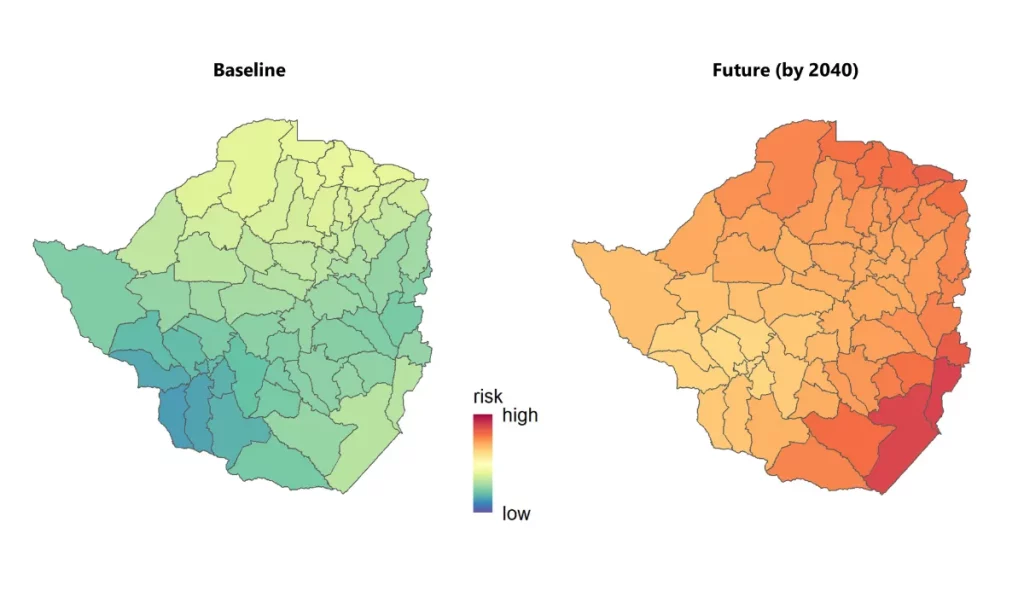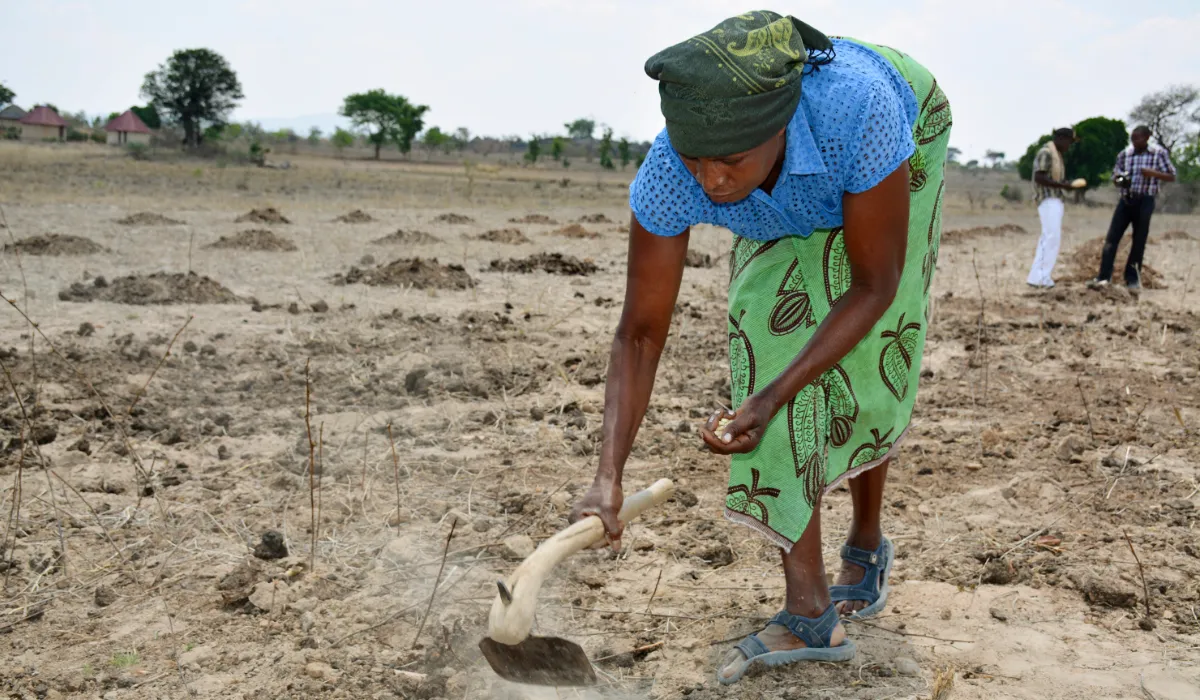This year, Zimbabwe experienced its worst drought in decades, affecting more than 80 percent of its population and leading to a declaration of a state of national disaster by the President. With climate impacts becoming more frequent and pervasive, risks to social cohesion, resilience, stability, and peace are on the rise, reshaping the country’s security and development landscape and making it more complex. Critical questions thus arise concerning what can be done and who would be best positioned to drive responses. There are no fixed answers to this, but recent developments in the national climate change policy architecture can open a window of opportunity for integrating elements of conflict-sensitivity and peacebuilding. This approach cannot be pursued by the Ministry of Environment, Climate Change and Wildlife alone; instead, it requires multi-stakeholder collaboration where all the concerned humanitarian, development, and peace sector actors play a role based on their respective expertise, skills and mandates.
Mainstreaming a conflict-sensitive and peacebuilding lens into climate change policy, legal frameworks and adaptation and mitigation programming can help build resilience and long-term environmental stability in ways that promote peaceful co-existence, collaboration and trust
Tweet
The context
Zimbabwe is one of the countries in Southern Africa most affected by climate variability and change. This is due to its complex climatic structure and economic dependence on rain-fed agriculture, which provides employment and livelihoods for about 70% of the population. Macroeconomic volatility, inflation, and high poverty rates compound this vulnerability, limiting access for most rural and urban farmers to the resources required for climate risk management and adaptation.
Recent shifts in temperatures and the onset of rains, as well as increases in the frequency and severity of heavy rainfall events and mid-season dry spells, have caused significant loss and damage to agriculture, livestock, food security and nutrition. For instance, the 2023-2024 farming season resulted in significantly below-average harvests due to the El Niño-induced drought, putting 4.2 million people into severe food insecurity. While agricultural and smallholder farming is the sector worst impacted by drought and failing precipitation patterns, limited hydropower production due to low water inflows in the Kariba Dam has affected the whole economy, leading to income losses, higher production costs and rising commodity prices. These factors have had cascading repercussions on economic growth, stability and employment.
For national and local authorities, particularly those in urban areas, these climate-induced disturbances have translated into difficulties in meeting the basic needs of an increasingly growing population, such as electricity, water and food. Rural-to-urban migration as a strategy to deal with agricultural hardships and economic uncertainty has contributed to rapid urbanisation and overcrowding of cities, straining already limited water resources and infrastructures. Water scarcity and lack of clean water have led to an increase in the spread of diseases like cholera due to poor sanitation and hygiene.
The deteriorating humanitarian situation is also attributable to the devastating effects of floods that are particularly felt around the Zambezi basin and the south-eastern part of the country. In 2019, following Cyclone Idai, storms and subsequent flash flooding and landslides led to the massive destruction of livelihoods and properties, affecting 270,000 people, 51,000 of whom were internally displaced. Approximately 5,300 refugees and asylum-seekers living in the Tongogara Refugee Camp were severely impacted, with 1,200 houses, latrines and boreholes entirely or partially damaged.

The climate scenario in Zimbabwe is only set to deteriorate further. Projections show that average annual temperatures are expected to increase by 1 – 1.5°C by 2040 from a 1986-2005 baseline. This increase in mean annual temperature could exceed 3°C by 2050, depending on the actual global emissions pathway achieved. Similarly, by 2040, Zimbabwe will face a rise in compound heat, drought and flood events compared to near-past baseline conditions (an average over the years 1981 to 2010; see Figure above).
Against this worrisome background, Zimbabwe has developed a robust policy framework to address climate change based on a dual strategy of adaptation and mitigation measures encompassing key economic sectors and social development. Key policies, strategies and frameworks include the National Climate Change Response Strategy, National Climate Change Policy, and National Determined Contributions. However, the country faces inadequate human and financial resources and mechanisms to implement, monitor and enforce these legal and policy frameworks.
Connecting the dots
In Zimbabwe, dominant climate change discourses have revolved around the consequences of climate and extreme weather events on ecosystem services, development and human security. However, these discussions do not fully consider the peace and security elements embedded in these climate-induced disruptions. Pressure on scarce natural resources, food insecurity, the declining viability of agricultural-based livelihoods, economic uncertainty, increased mobility and displacement, and poorly managed urbanisation reshape community and social relations to generate dynamics that can disrupt social cohesion, resilience, stability and peace. However, the recent statement by Zimbabwean President, His Excellency Hon Emmerson Mnangagwa, who recognised climatic factors as critical to understanding the contemporary peace and security challenges that cascade across Africa, underscores the importance of these issues.
In view of this nexus, climate change cannot be treated in isolation from the broader peace and conflict systems in which it manifests and vice-versa. From a climate action perspective, it implies that a business-as-usual approach will prevent adaptation and mitigation initiatives from realising their full potential. In the worst case, it may exacerbate conflict potential by reinforcing existing social tensions, negative coping strategies and social inequalities. Conversely, mainstreaming a conflict-sensitive and peacebuilding lens into climate change policy, legal frameworks and adaptation and mitigation programming can help build resilience and long-term environmental stability in ways that promote peaceful co-existence, collaboration and trust. The Zimbabwe climate change policy architecture strategically creates an enabling environment for such integration through its cross-sectoral approach to climate action strategies.
Micro-and macro-level dynamics can increase the risk of social instability and conflict in the short to medium term, especially if climate-related weather conditions keep worsening. Acting now is, therefore, of foremost importance.
Tweet
As the first National Adaptation Plan (NAP) is set to be released and the Climate Change Bill is at its validation stage, 2024 could be a good year for advancing the climate, peace, security and migration agenda. The current effort of the African Union (AU) to develop a Common African Position on Climate, Peace and Security builds further momentum, and it could allow the Government of Zimbabwe to align its policy architecture with the emerging African Common Position and reaffirm its commitment to Africa’s Agenda 2063.
With this in mind, the Alliance of Bioversity International and CIAT, in collaboration with the Zimbabwe Ministry of Agriculture and the Ministry of Environment, ACCORD and the Southern Africa Partnership for the Prevention of Conflict (SAPPC), convened a two-day workshop in Harare on 27 and 28 May 2024. The event brought together approximately 95 experts and representatives from the Ministry of Environment, the Ministry of Agriculture, the Ministry of Defence, the Ministry of Home Affairs, civil society, academia and international organisations.
The purpose of the workshop was two-fold: to document conditions under which climate-related risks to peace and security can manifest and identify entry points to prevent and mitigate these risks. Participants discussed several possible pathways of interaction between climate change impacts and peace and security dynamics. The first pathway identified is competition over natural resources, triggering tensions within and between communities and even localised (violent) conflicts, as in the case of clashes over grazing land and water resources. These effects are exacerbated by other risk factors like poor water management, unsustainable harvesting practices, and land-cover/land-use changes due to the expansion of mining and population growth.
The second pathway is livelihood and food insecurity, explaining the destabilising social impact of climate change. Loss of agriculture-based livelihoods and resulting unemployment and economic uncertainty push people into negative coping mechanisms to make a living, affecting social contract and community cohesion. This includes early marriage and girl child school dropout, reliance on illicit artisanal mining as an alternative source of income, as well as cattle rustling. Moreover, in urban environments, feelings of frustration and resentment against authorities are mounting due to shortages of electricity and maize, as well as food price spikes that challenge the capacity of the urban poor to afford basic commodities. The third pathway is mobility and displacement due to droughts, floods and adverse weather patterns that create tensions with host communities over access to food, water and employment opportunities, especially in the absence of adequate regulatory frameworks to manage the influx of newcomers.
According to participants, these micro-and macro-level dynamics can increase the risk of social instability and conflict in the short to medium term, especially if climate-related weather conditions keep worsening. Acting now is, therefore, of foremost importance. A clear overarching priority is strengthening household and community resilience capacities rather than increasing humanitarian assistance support; this can be achieved through better integration of disaster risk management into adaptation and mitigation measures. At the same time, while the flexibility of existing climate change policies and strategies could allow for incorporating elements of conflict-sensitivity and peacebuilding, participants agreed that all these efforts should include traditional leaders and Indigenous Knowledge Systems (IKS) and be implemented accordingly. This requires effective resource mobilisation plans and better coordination between ministries and with civil society groups. As such, partnerships with the private sector and the establishment of a multi-stakeholder governance mechanism were identified as promising ways forward.
While different actors have specific roles to play according to their respective expertise, skills and mandates, collaborative and coordinated efforts to realise the complementary approaches outlined above would enable Zimbabwe to achieve the goals of Africa’s Agenda 2063 and the 2030 Agenda, i.e. the Sustainable Development Goals.
Giulia Caroli is a climate, peace and security specialist at the Alliance of Bioversity International and CIAT, one of the research institutes at CGIAR. Cedric de Coning is a senior advisor at ACCORD and a Research Professor at the Norwegian Institute of International Affairs (NUPI). Gracsious Maviza is a gender, migration and climate security scientist at the Alliance of Bioversity International and CIAT, at CGIAR. Joram Tarusarira is a climate security research associate at the Alliance of Bioversity International and CIAT, at CGIAR, and an assistant professor at the University of Groningen in the Netherlands. Henintsoa Onivola Minoarivelois a scientist at the Alliance of Bioversity International and CIAT, at CGIAR.
Nqobile Moyo is the Regional Coordinator of the Southern Africa Partnerships for the Prevention of Conflict (SAPPC).
This work is carried out with support from the CGIAR Initiative on Fragility, Conflict, and Migration. We would like to thank all funders who supported this research through their contributions to the CGIAR Trust Fund: https://www.cgiar.org/funders/.







